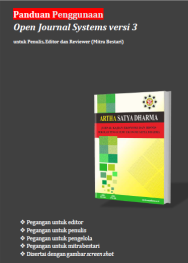Sustainability SUSTAINABILITY OF UMKM RELATED TO RELIGIOUS CUSTOMS CEREMONY IN BALI (Study of Bokor Craftsmen in the Village of Menyali)
Abstract
The purpose of this study was to determine the role of traditional ceremonies in Bali on the sustainability of bokor craftsmen in Menyali Village. This research uses a qualitative approach. Data collection techniques used in this study were in the form of interviews, observations, and documentation. The informants of the research are business owners, consumers, and employees who are deep in knowledge about the bowl. The bokor craft is an industrial activity that already existed in the 1980s and is now a supporting activity for income generation for the village community. In general, bowl is used as a means of worship of Hindus, among others: bowl, pan, sangku, taboo, saab etc. Of these industrial activities will certainly produce products that will later be widely used by the community to conduct a ceremony. Traditional ceremonies such as Pitra Yadnya, Dewa Yadnya, Rsi Yadnya, Bhuta Yadnya and Manusa Yadnya. Of the traditional ceremonies that play the most important role in using the bowl is the Pitra Yad ceremony, which often occurs in April to August. The increase in income from the day is usually compared to when there is a traditional ceremony income to increase by around 50-70%. The research aims to determine the sustainability of MSMEs related to traditional religious ceremonies in Bali.
Downloads
References
Artini, et.al, (2006). Tingkat Kesejahteraan Penduduk di Badung Utara dan Badung Selatan. Denpasar.
Clifford.G. (2004). Pengertian Upacara Adat. http://www.indonesiastudents.com/pengertian-upacara-adat-menurut-para-ahli.
Danoko. F, (2008). Strategi Pengembangan Usaha Kecil. Universitas Kristen Krida Wacana. Jakarta.
Ghazali.A.M. (2011). Antropologi Agama. Bandung: ALFABETA.
Jogiyanto. (2008). Metode Penelitian Bisnis. Yogyakarta: BPFE
Marzuki,N.N.(2015). Simbolisme dalam Upacara Adat : Kajian terhadap upacara adat Karampuang di Kabupaten Sinjai Sulawesi Selatan, tesis, Sekolah Pasca Sarjana Universitas Gajah Mada.
Marianto,M.D.(2012), Seni Kritik Seni, Lembaga Penelitian Institut Seni Indonesia, Yogyakarta.
Mudrajat. Kuncoro. 2004. Definisi Usaha Mikro Kecil dan Menengah. http://www.academia.edu/pengertian-umkm.
Riyanto, B..(2013). Dasar-dasar Pembelanjaan Perusahaan. Edisi Tiga Cetakan Ketujuh belas, Yogyakarta. Penerbit Yayasan Penerbit Gadjah Mada.
Rudjito. (2006). Strategi Pengembangan UMKM. Edisi Revisi. Penerbit Gramedia Pustaka Umum. Jakarta.
Sugiyono. (2014). Metode Penelitian Kuantitatif, Kualitatif, dan R & D. Cetakan ke-18. Bandung: ALFABETA
Sukirno, S. (2006). Teori Pengantar Ekonomi Makro. Jakarta: Pt Raja Grafindo Persada.
Soedarso S.P.(2010), Trilogi Seni Penciptaaa Eksistensi dan Kegunaan Seni, BP. ISI.Yogyakarta
Tambunan, T.(2012),.Usaha Kecil dan Menengah di Indonesia: Jakarta. LP3ES,.
UU No 20 Tahun 2008 tentang Usaha Mikro Kecil dan Menengah.


